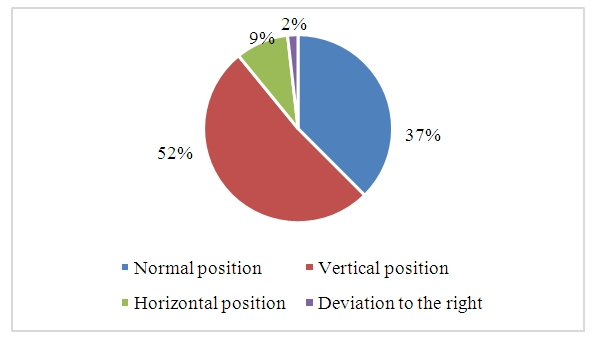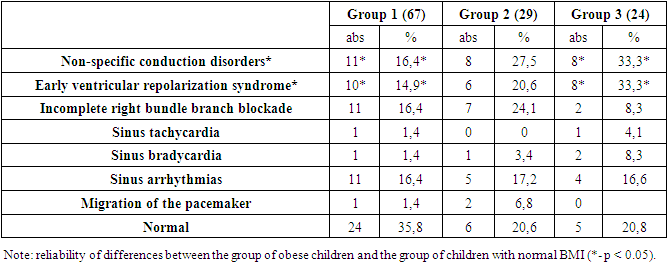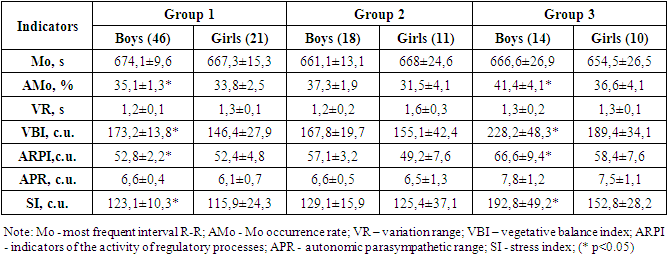-
Paper Information
- Next Paper
- Previous Paper
- Paper Submission
-
Journal Information
- About This Journal
- Editorial Board
- Current Issue
- Archive
- Author Guidelines
- Contact Us
American Journal of Medicine and Medical Sciences
p-ISSN: 2165-901X e-ISSN: 2165-9036
2024; 14(5): 1285-1288
doi:10.5923/j.ajmms.20241405.28
Received: Apr. 22, 2024; Accepted: May 10, 2024; Published: May 14, 2024

Disorders of the Functional State of the Cardiovascular System in 7-Year-Old Children with Overweight and Obesity
Popenkov Artur Viktorovich, Akhmedova Dilorom Ilhamovna
Department of Hospital Pediatrics № 2, Tashkent Pediatric Medical Institute, Tashkent, Uzbekistan
Correspondence to: Popenkov Artur Viktorovich, Department of Hospital Pediatrics № 2, Tashkent Pediatric Medical Institute, Tashkent, Uzbekistan.
| Email: |  |
Copyright © 2024 The Author(s). Published by Scientific & Academic Publishing.
This work is licensed under the Creative Commons Attribution International License (CC BY).
http://creativecommons.org/licenses/by/4.0/

The purpose of the study to reveal disorders of the functional state of the cardiovascular system in 7-year-old children with overweight and obesity. Materials and methods: 120 children aged 7 years were selected for the study. All children were anthropometrically examined. Height and weight were measured and body mass index was calculated. On the basis of BMI values, the children were divided into 3 groups. The children underwent electrocardiography and cardiointervalography with calculation of heart rate variability. Results: Among children with functional heart disorders more often noted: sinus arrhythmia - in 20 children (16,6%,); early ventricular repolarization - in 24 children (20%), of which class I disorders made up 24%, class II - 72%, class III - 4%; non-specific ventricular conduction disorders - in 27 children (22,5%); incomplete right bundle branch block in 20 children (16.6%); sinus bradycardia in 4 children (3%); pacemaker migration in 3 children (2.5%) and sinus tachycardia in 2 children (1.6%). Conclusion: Overweight and obese children have a higher percentage of functional disorders than children with normal body mass index. Sinus arrhythmia, early ventricular repolarization syndrome and non-specific cardiac conduction disorders are more common in overweight and obese children.
Keywords: Children aged 7 years, Functional heart disorders, Overweight, Obesity
Cite this paper: Popenkov Artur Viktorovich, Akhmedova Dilorom Ilhamovna, Disorders of the Functional State of the Cardiovascular System in 7-Year-Old Children with Overweight and Obesity, American Journal of Medicine and Medical Sciences, Vol. 14 No. 5, 2024, pp. 1285-1288. doi: 10.5923/j.ajmms.20241405.28.
Article Outline
1. Introduction
- Overweight and obesity are among the leading non-communicable diseases worldwide [4,7]. Even at the end of the last century, this disease was more characteristic of the adult population, but recent decades have been characterized by a high rate of prevalence among children [6].According to the World Health Organization (WHO), in some countries of the WHO European Region, every third child between the ages of six and nine years is overweight or obese [11]. This problem is currently exacerbated by the new coronavirus infection COVID-19. COVID-19 has the potential to exacerbate one of the most worrying trends in the WHO European Region, the increasing prevalence of childhood obesity [9].Studies have also been conducted in Uzbekistan to determine the incidence of overweight and obesity among children under 5 years of age. According to the results of this study for the period of 2019, the incidence of obesity was 4.6%. [7], while in the neighboring countries Turkmenistan (period 2015-2016) [8] and Kyrgyzstan (period 2017-2018) the percentage of obese children was 5.9% and 2.6% [12].Overweight and obese children have a high risk of developing hypertension, insulin resistance, they are also at increased risk of fractures and psychological problems. The development of cardiovascular diseases is directly related to overweight and obesity occurring in childhood [9].According to WHO, cardiovascular diseases are the main cause of death worldwide [10]. Overweight and obesity affect the functional state of the cardiovascular system. According to the results of numerous studies, the relationship between overweight and obesity and early manifestations of cardiac dysfunction has been revealed [3]. In overweight and obese children sinus rhythm disorders, intraventricular conduction disorders and repolarization disorders are common. Dysregulation of the autonomic nervous system is also noted, which has an impact on decreased adaptation of children. Hyper activation of the sympathetic nervous system is noted in obese children [5].
2. Purpose of the Study
- To identify the disorders of functional cardiovascular activity in children aged 7 years with overweight and obesity.
3. Materials and Methods
- 120 children aged 7 years participated in the study. All children were anthropometrically examined. Height and weight were measured and BMI was calculated. On the basis of body mass index (BMI), the children were divided into 3 groups: Group 1 - 67 children with BAZ (BMI to age) ranging from -2 to +1 SDS (normal); Group 2 - 29 overweight children (BAZ +1 to +2 SDS); Group 3 - 24 obese children (BAZ more than +2 SDS). The children underwent electrocardiography and cardiointervalography with calculation of heart rate variability (HRV). Variational pulseoximetry was used to analyze HRV. Statistical significance of the obtained measurements when comparing mean values was determined by Student's t-test with calculation of the probability of error (P). The level of reliability P <0.05 was taken as statistically significant changes.
4. Results
- According to the results of anthropometric measurements, the following average anthropometric indices were obtained: the average weight of children according to sex in the observation groups was as follows: In group 1 (WAZ - 0.39): weight of boys - 25.74±0.51 kg, girls - 25.43±0.72 kg); in group 2 (WAZ - 1.94): weight of boys - 33.83±1.08 kg, girls - 30.36±1.66 kg; in group 3 (WAZ - 2.54): weight of boys - 41.57±1.72 kg, girls - 40.5±3.66 kg. The mean height of children was: in group 1 (HAZ - 0.66): boys - 128.17±0.89 cm, girls - 129±1.54 cm); in group 2 (HAZ - 1.26): boys - 133.83±1.49 cm, girls - 128.27±2.34 cm; in group 3 (HAZ - 0.87): boys - 136.14±2.15 cm, girls - 134.06±3.66 cm. The mean body mass index (BMI) of children was in group 1 (BAZ - -0.02): boys - 15.60±0.16 kg/m2, girls - 15.23±0.21 kg/m2; in group 2 (BAZ - 1.74): boys - 18.79±0.23 kg/m2, girls - 18.32±0.39 kg/m2; in group 3 (BAZ - 2.73): boys - 22.35±0.58 kg/m2, girls - 22.1±0.79 kg/m2 (Table 1).
|
 | Figure 1. The position of the electrical axis of the heart in 7-year-old children |
|
|
5. Discussion
- Overweight and obesity are characterized not only by an increase in body weight and BMI of children, but also by an increase in height. The greatest growth among children was observed in the obese group, followed by overweight children. During electrocardiography in children, in more than half of the cases the vertical position of the electrical axis of the heart was noted, which may be characterized by an increase in the growth rate of children in this age period. Heart rate is not an indicator that varies significantly between study groups. Although this indicator was higher in obese children, no significant differences were found. When electrocardiography was evaluated, a high percentage of functional abnormalities was found among all the children studied. Only ¼ of the children had normal indices. Non-specific conduction disturbances, early ventricular repolarization syndrome were more frequent in obese children. Nonspecific conduction disturbances, early ventricular repolarization syndrome were also more common in overweight children. Also quite a high percentage of children had incomplete blockade of the right bundle branch of Hiss, but no significant differences between the groups were found. The highest percentage of children without functional disorders was observed in the group of children with normal body mass index.According to cardiointervalography, it is noted that the state of the autonomic nervous system changes depending on body mass index. So it was revealed that obese boys have higher values of AMo - percentage of the most frequent R-R interval and VBI - index of vegetative balance, reflecting the state of the sympathetic link of the vegetative nervous system, the higher this index is, the higher the activity of the sympathetic nervous system. Also in boys with obesity there is a high index of ARPI - index of adequacy of regulation processes, the higher this index is, the lower in the organism reserve possibilities for adaptation. Stress index most clearly reflects the state of the autonomic nervous system under stress [1]. In obese children this index significantly exceeds the index of children with normal body mass index. Moreover, it was revealed that the sympathetic nervous system predominates in the majority of children. [2] However, in girls, regardless of the group, there were no significant differences in the indicators. This may be due to the fact that girls have a higher adaptive potential of the autonomic nervous system.
6. Conclusions
- According to the obtained data we can conclude that obese children have high activity of sympathetic and central nervous system. Moreover, they have low compensatory potential in comparison with children with normal BMI, which, in turn, is reflected in functional disorders of cardiac activity. Obese children have a higher percentage of functional impairment than children with normal BMI. In overweight and obese children, early ventricular repolarization syndrome and non-specific cardiac conduction disorders are more common.
Conflict of Interest
- The authors declare no conflicts of interest or special funding for the current study.
 Abstract
Abstract Reference
Reference Full-Text PDF
Full-Text PDF Full-text HTML
Full-text HTML

